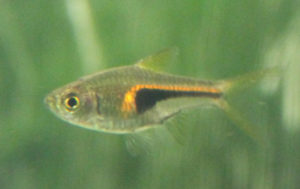
Scientific Name Trigonostigma Hengeli
Family Cyprinidae
pH 5.5 – 7.5
dH 1 – 14
Temp 22 – 28 degrees
Life Span 3 – 5 years
Origin
Sumatra & Borneo Islands in Indonesia. They reside in blackwaters and slower flowing streams.
Description
The Hengeli Rasbora is also called the Growlight Rasbora. Being the smallest of the trigonostigma genus the Hengeli will grow up to 3 – 4cm in length. Most of their body is translucent with the most significant feature, a bright orange marking on the lateral line from the centre of its body to the Caudal fin with a black marking underneath this. Males are not as round as the females. Although this species of Rasbora is quite hardy it is not recommended to use this fish while cycling a new aquarium.
Environment
Provide a tank that is dimly lit with lots of plants for hiding spaces as the Hengeli is a shy fish. Keep filter flow to a minimum, allowing wide open spaces for them to swim around in as they are quite energetic. A darker substrate will help to bring out the Rasbora’s colours. They can tolerate a wide range of conditions. Maintain pH from 5.5 – 7.5 and soft to moderately hard water 1 – 12 dGH. Minimum tank size for a group should be at least 100 litres.
Behaviour
The Hengeli Rasbora is extremely peaceful and suitable for any aquarium with non- aggressive fish. The more placid the better. It’s a shoaling fish and best kept in a group of at least 6 or more as this makes them feel more relaxed about their environment. The more the better when it comes to shoaling fish. A hierarchy will be formed within the group. The main area of the tank it likes to reside in is the middle, but it will frequent the top and bottom as well. This species of Rasbora is a faster swimmer than other Rasbora’s.
Food
The Hengeli Rasbora is an omnivore so it will enjoy a wide range of foods as it is not too fussy. Flake food, worms, live and frozen food like brine shrimp, daphnia, mosquito larvae & vegetables. Keep serving sizes small as they are not big fish.
Disease
There are no specific diseases that directly affect this species but they are prone to the variety of others.
Breeding
Although very difficult to breed in an aquarium it can be achieved. Keep water conditions optimal, providing them with soft acidic conditions. They will attach their eggs to the undersides of leaves. To induce spawning keep the tank quite dark, feed lots of live foods and even do water changes to simulate a change of seasons. So the parents do not eat their young, they should be removed after spawning. Feed young infusorians to begin, moving onto brine shrimp and then powdered fry foods as they get bigger.
